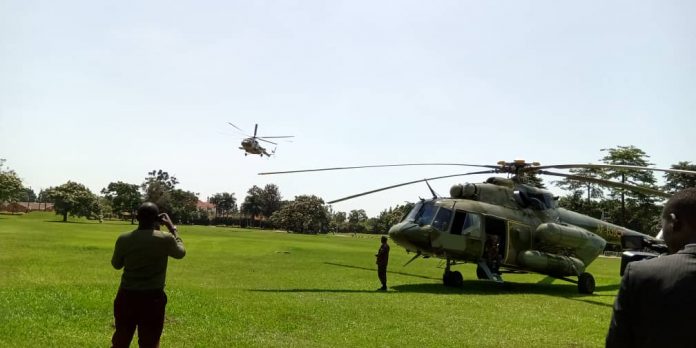The government has airlifted pesticides to Karamoja to contain the desert locusts that have already started spreading to different parts of the sub-region.
The pesticides were on Monday, February 10, 2020, airlifted by an army helicopter from Kololo Independence Grounds in Kampala.
The Prime Minister Dr Ruhakana Rugunda on Sunday said the country is “reasonably prepared” to respond to the invasion of the desert locusts.
This after government confirmed an invasion of Desert Locusts in parts of Amudat, Nabilatuk and Nakapiripirit, some of the areas in in Karamoja sub region that share a common border with Kenya.
Stephen Tibeijuka Byantwale, the Commissioner of Crop Protection at the Ministry of Agriculture, Animal Industry and Fisheries, says government has been preparing for these locusts for the past two weeks and hopes they will contain them.
Tibeijuka, who is also the head of the Inter-Ministerial Task Force set up to fight Locusts says some of the requirements including chemicals, pumps and sprays are already on ground while others are to be airlifted Monday morning.
State Minister for Agriculture Aggrey Bagiire says that after receiving reports that the locusts had entered the country on Sunday afternoon, response teams were dispatched to the three districts at around 3p.m. and later confirmed the invasion.
Bagiire added that the Agriculture Ministry has already prepared both manual and automatic pumps for dispatch early morning to Karamoja. He discloses further that they have in stock the chemicals for spraying some using motorized spray pumps and others manual.
Bagiire says the exercise requires a lot of water and they have asked the districts to avail their water bowsers and other equipment to support the fetching and delivery of water.
Already, State Minister for Relief and Disaster Preparedness Musa Francis Ecweru and Minister for animal industry Bright Rwamirama are already in Nairobi to negotiate for aircraft to support in aerial spraying of the locusts.
Government has listed three chemicals to use in the spray against the desert locusts. They include Fenitrothion 96 per cent low volume formulation, which is a phosphorothioate insecticide.
Others are Malathion which is an organophosphate insecticide. This is commonly used to control mosquitoes and a variety of insects that attack fruits, vegetables, landscaping plants, and shrubs as well as Pyrethroid insecticides.
According to Tibeijuka, when nymphs of the locusts are still down, that massively move on the ground, government plans to use a special chemical class of active insecticide known as Pyrethroid insecticides which he says disintegrates within seven hours of spray.
He says Arial spraying will be done during early mornings before the Locusts swam and late in the evening when they have rested to ensure targeted delivery.
Tibeijuka says Ugandans should not worry about the chemicals being used as they are less harmful to human life since they have been used overtime.
“There is no way how a UN agency working with government can use a product that is harmful to the environment, harmful to people. These products have been tested and approved for this purpose,” says Tibeijuka.
Adding that; “…there are standard measures and this is why the UPDF is in place. Where we have the sensitive ecosystems such as swamps and water bodies, we do it on the ground. Where it is possible to do Arial spraying we do it and therefore all those mitigation measures are in place.”
Government has also disclosed that the deployment of 2,000 Uganda People’s Defense Forces (UPDF) officers has started. The officers have been undergoing training from Aswa – Lolim.
Security Minister, Gen. Elly Tumwine says the Army is jointly joined by all other security agencies in the operation. He says they are using experiences of the countries in the region to handle the invasion.





















